(Not necessarily in that order.)
One day in 1993, my Dad came downstairs to the “computer department” at Olcott International somewhat agitated. He was upset that a function called “Prior Art” was not included in the patent management software. There were plenty of blank looks all around. “Prior Art? What’s that?” and “Why didn’t we know about this before?” were suddenly questions that hung in the air like old party balloons.
“You dumb bastards!” Dad shouted at the programmers. “You don’t know anything about patents!” At least not like him; after all, he was a high priest, a “made” patent attorney.
Bob Gerhardt took a shot at resolving the problem. “Bern,” he grunted as he worked that wad of gum in his mouth, “We can add Prior Art information in the header text field.” Reasonable, that.
Dad shot back, “Is it labelled ‘Prior Art’?” Although his knowledge of software was surprisingly spotty, he knew full well the answer to that question.
Bob grunted again, softer this time, “no.” He was beaten, again.
“I want a Prior Art field and I want it labelled ‘Prior Art’!” he bellowed like the Breakstone sour cream boss who hounded his employees if the product wasn’t thick enough.
A little background is probably helpful at this point. On Prior Art, that is, not on sour cream or grapes.
So what is “Prior Art?”
It’s a set of disclosures that form part of an initial patent application. It’s a summary of publicly available information that relates to the invention at hand. A successful application will make many references to Prior Art, primarily to distinguish the new invention from previously known related gadgets and concepts. The written description will in fact take great pains to define exactly how the new mouse trap is different and superior.
As to the second question above (‘why didn’t we know this before?’), I guess my Dad hadn’t thought of including Prior Art previously in the company software product. Anyway, he thought of it now and it needed to be added! Immediately! No patent attorney would take such a PMS seriously without it! Do it! Otherwise it’s useless! (Dad was often frustrated by the inability of software developers to understand even the simplest patent procedure).
The problem was that, like altering the requirements for a bridge midway through construction, too many changes made mid-course inevitably would lead to buggy software burdened by inconsistencies. Such as the use of the “Tab” key, for instance.
In any software product the world over, screens chock full ‘o fields can be navigated easily using the “Tab” key to go from one field to the next. One of the bugs in our PMS, however, was inconsistent handling of the “Tab” key. Occasionally, on hitting the “Tab” key, the cursor would not budge; it would just sit there blinking. The hapless user would be forced to use the mouse and actually click on the next field to advance. This could prove to be distracting to potential new users.
If I had been consulted, I would have remarked that the addition of such a specific field for “Prior Art” could well prove to be one of many features to distinguish our product from the competition. However, scope needs to be managed very tightly. Like bridges, once the project is defined, one is well advised to avoid most, if not all, additions or changes. The benefit is that you get to complete your project on time or ahead of schedule. Not only that, you arrive with a handy list of things to do for the next phase.
Without this careful scope control, a well-intended effort to please everyone can too easily result in a bloated project that never completes. The risk is that the list of things to do grows faster and larger than the list of finished items. Scope-creep is a very real problem! If not managed correctly, a project could collapse, just like the Tacoma Narrows Bridge.
But alas! At Olcott International, I wasn’t management in anything but in name only. I certainly wasn’t consulted to define project scope, set strategic directions, or do anything having to do with “vision.”
But I found myself with 3 separate Patent Management Systems. Undeniably, all 3 had to be tested. And how do you do that? Load them up with patent data. And get them loaded, I did.
To do this, I needed to make up plausible sounding inventions and then populate all the fields in the software, as if these were successful applications that then benefitted from a worldwide filing program.
A word is in order about the nature and marketability of patent ideas, particularly for you potential inventors out there. Dad had some opinions about this, and on this topic, I still think his opinion is inviolate.
“Most patents are worthless, utterly worthless,” he would tell anyone who casually asked him on the street about patenting a new invention. I heard this speech more than a few times hanging on his elbow.
Consider the kissing guard:
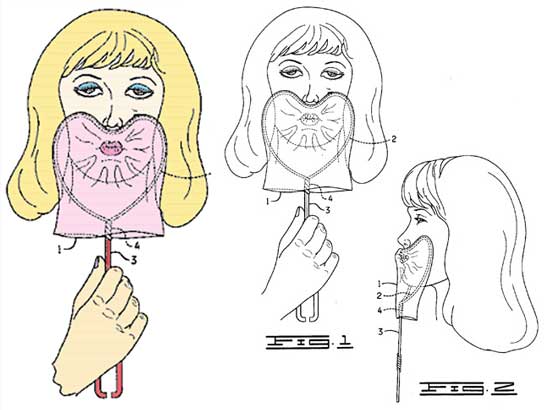
Useful in preventing diseases, right? However, as Dangerfield would say, “with a face like that, she doesn’t need one!”
Or this one? Can you guess what this is all about? I cannot…
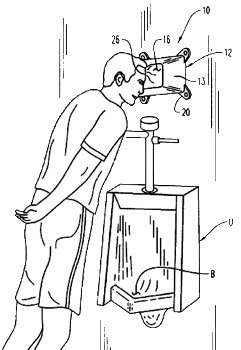
The one below, I imagine, would be a great ‘Plan B” in case our atmosphere turns poisonous. This handy hose would allow you to breathe the clean air behind the toilet water; kindly examine the cavity marked ’25’ in the illustration.

This one would have been helpful as a motivator in offices everywhere:
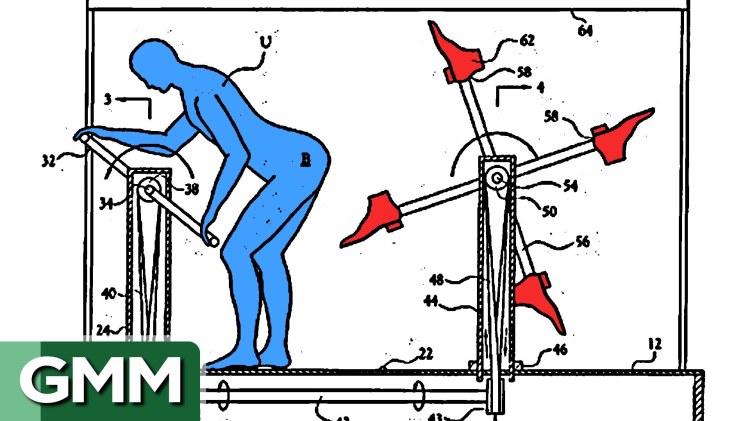
And of course this:
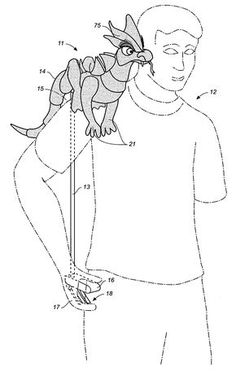
In case you can’t guess, the above illustration was from a patent for an “Articulable Shoulder Puppet.” Now you know what to get for that special person who has everything.
My poor Dad was made to suffer through such ideas constantly. It’s the bane of being a patent attorney; everybody has an idea that they want to “tell” you about.
For example, one night, my Mom and Grandmother polished off a bottle of wine together while devising an idea for a brand new patent. They just knew that they had hit pay dirt! Their new idea was going to make them rich, stinking rich. In fact, they even opened up a bottle of champagne that night to celebrate their achievement.
I wish I could have witnessed this joy festival with my Mom and Grandmother (but I missed it). Blessed are those so easily entertained.
What was their idea, you may ask?
It was a can of aerosol spray that could be squirted on dogshit. The secret sauce therein would cause a reaction with the excrement and turn it into dust. Imagine it, making shit disappear! Something that humans have pined for since the Bronze Age! Kinda like Dracula in an old Hammer film, turning into dust when exposed to sunlight. Everyone would buy this, don’t you think so?
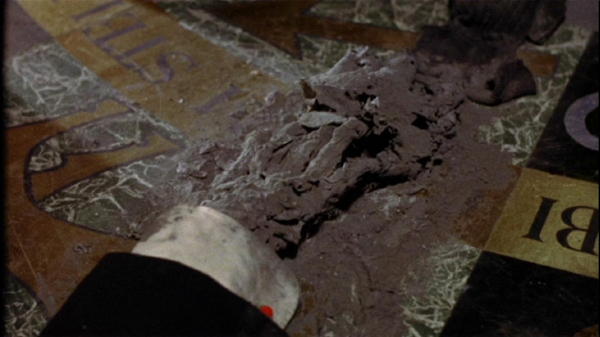
Can any astute reader identify for me, please, the number one problem in obtaining a patent for this “idea”? Please respond in the comments section below.

Eventually dogshit turns to dust on its own without any help from an aerosol spray?
LikeLiked by 2 people
This was a creative and insightful guess. But not the main reason why it could not be patented.
LikeLike
People will start squirting it on humans?
LikeLike
Patents are not granted on the basis of whether or not humans (or others) attempt to spray people (or blogs) with the product. Be careful, though, not to get any on your hands!
LikeLiked by 1 person
Beg your pardon?
LikeLiked by 1 person
Blessed are those who can take a joke. Especially from a blog about dogshit.
LikeLiked by 1 person
Scatological humor passes the smell test…mini-ha-ha
A doggerel on dog-shit? I like it!
LikeLiked by 1 person
I wrote it. You read it!
LikeLike
Can any astute reader identify for me, please, the number one problem in obtaining a patent for this “idea”?
I have four (4) guesses:
[1] the whole idea was shit-canned
[2] Chlorofluorocarbons were banned in 1978
[3] Aerosol cans were still patent-protected
[4] A turd in the can is worth two in the tush
James, in any case, this story was a hoot. Thanks for making me laugh old squirt…er sport!
LikeLiked by 2 people
1) The fact that “shit” is the subject of the patent application does not disqualify it for a patent. Look, there are lots of patents on toilets.
2) You can write a patent dealing with a banned substance, so no.
3) The patent on aerosol cans ran out a long time ago.
4) No, no, and no.
Thank you for enjoying this post, Ned. There are products in your local drugstore to help you with your symptoms, depending on the exact nature.
I will reveal the answer to my question in a few days. Are there any patent attorneys among the readers who wish to comment?
LikeLiked by 2 people
They might have been able to get a patent for the sauce – but not for secret sauce!
LikeLiked by 3 people
This is the correct answer! You can’t get a patent for an idea. You have to patent the compound in the spray. Anyone know the chemistry involved in fast-degrading dogshit?
LikeLiked by 2 people
So, Coca Cola has never patented its secret sauce because to do so would make the formula public information? By the way, fun way to engage readers!
LikeLiked by 1 person
That’s one reason. Another might be the difficulty in patenting a “flavor” or “recipe.” Any patent attorneys want to comment on this?
LikeLike
They might have been able to get a patent for the sauce – but never for a secret sauce!
LikeLiked by 2 people
“Vapoorize!” Yes, the joy of being a patent attorney is hearing all the ideas from people without any clue how to reduce their “idea” to practice.
LikeLiked by 2 people
Yeah, if l got a dollar for every idea l have had…
LikeLiked by 2 people